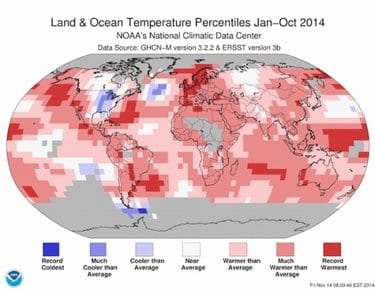A surge of Arctic air has left much of the continental U.S. shivering in unusually bitter November cold. But this early foray into winter weather is just a small blip in the overall global picture, which is of a warming world that is still on track to see 2014 set the mark for hottest year on record, the National Oceanic and Atmospheric Administration said Thursday.
That warming — fueled largely by the manmade rise of greenhouse gases in Earth’s atmosphere — is so relentless, in fact, that the odds of seeing a record coldest year in the future are vanishingly small. As the animation below shows, the last time the world experienced a record-coldest year was in 1909, more than 100 years ago. But in that period, 18 records for warmest year have been set, with 2014 likely to be the 19th.
Much of the central and eastern parts of the contiguous U.S. have been relatively cool all year, with a few states even possibly set to see a top 10 coldest year. But the year as a whole has actually been close to average for the country, and California is set to see its warmest year on record by a large margin.
The bigger picture is markedly different. The globe is bathed in warm spots, with the small cold spot centered over the Great Lakes area being just one of a handful of blue spots on the world map.
August, September and October of 2014 have all been the warmest such months on record, as shown by data from NASA, the Japan Meteorological Agency and NOAA, which released its October global numbers Thursday.
This single-year snapshot of the planet’s warmth fits with the pattern of ever-warmer temperatures that has been in place over the past century, particularly since the early 1980s as the warming fueled by an accumulation of greenhouse gases clearly emerged. The animation shows just how much warmth has dominated the temperature records since they began in 1880.
Record cold years are plentiful in the early decades, but they stop in 1909. From there, it’s a steady march upward, with the expected year-to-year ups and downs that come from natural variation. Warm records are set through the 1930s and 40s, with a long stretch of no records until the 1980s, when the global warming signal firmly emerges from the noise of natural variation.
After that, a string of record hot years follows. And though many of the years in between weren’t records, they still ranked among the warmest. In fact, all but one of the 10 warmest years on record have occurred in the 21st century (1998, when there was a very strong El Niño, is the exception).

“The globe continues to warm just as climate models have long-predicted,” climate scientist Michael Mann, of Penn State, said in an email.
The steady uptick in warming, even with a relative slowdown in recent decades, means that the likelihood of seeing a record cold year in the future is, according to a quick calculation by Mann, “astronomically small.”
The final year in the animation, 2014, is of course not yet over. But with the October numbers now in, the year-to-date is the warmest on record, measuring 1.22°F above the 20th century average of 57.4°F, according to NOAA data. The chances of 2014 becoming the warmest year are now quite high. Even if November and December only rank in the top 10 warmest, which is likely, 2014 will take the title of warmest year.
“It’s becoming pretty clear that 2014 will end up as the warmest year on record,” Deke Arndt, chief of climate monitoring for NOAA’s National Climatic Data Center, said during a press conference.
And as the animation shows, it’s a long-term trend that is likely to continue until the emissions of carbon dioxide and other greenhouse gases are significantly curtailed.
Mann said of the possible record, “hopefully it will also drive home the urgency of reducing carbon emissions if we are to avoid dangerous interference with our climate.”
Editor’s note: Two years that tied records were not represented in the animation: 1911 tied 1909 for coldest year and 1930 tied 1926 for warmest at that time.
Source: Climate Central. Reproduced with permission.








